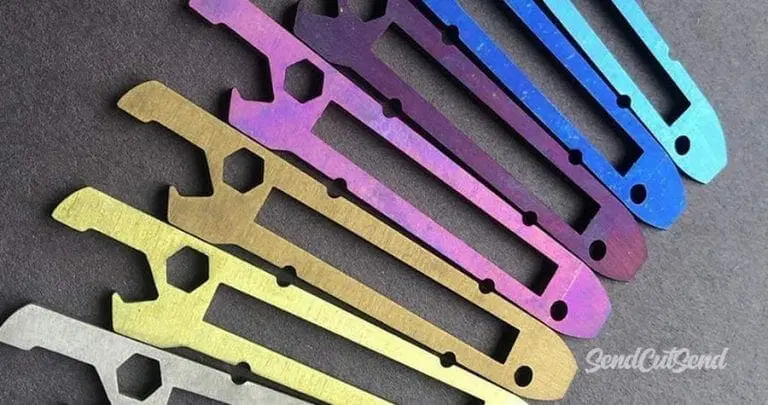Anodized aluminum’s versatility, durability, and performance make it indispensable across various sectors, from aerospace to consumer electronics. However, the process aggregates several steps and variables, contributing to differences in time to the anodized aluminum part.
The time to anodized aluminum parts depends on the type of anodizing, the capability of the anodizing service, and the supply or logistic chain. This article will explore how anodizing works and dissect the factors that impact the lead time of anodized aluminum parts.
What is Anodized Aluminum?
Anodized aluminum is an anodized metal that has been transformed at the molecular level through an electrochemical process that forms a protective oxide layer. This layer bolsters the aluminium’s resistance to the elements, enhances surface hardness, and brings vibrant color possibilities.
The anodizing process begins by immersing the aluminum part in an acid electrolyte bath. This is followed by passing an electrical current, which causes the aluminum surface to oxidize in the presence of oxygen. This controlled oxidation improves the metal’s structural properties and color options.
The architectural and automotive sectors value the effects of anodizing aluminum, using the resulting metal part for everything from vehicular components to building structures.
Key Factors Affecting Lead Time of Anodized Aluminum Parts
The different factors that affect the lead time of anodized aluminum parts can be divided into process intricacies, material, and supply chain factors, as highlighted below.
Type I, II, and III Differences
The three primary types of anodizing differ mainly in thickness and hardness, which can relate to the longer time it takes to anodize aluminum parts. Type I uses chromic acid, offering a thin, lightweight, protective coat suitable for aviation. It is also the fastest of the three types of anodizing.
Type II, using sulfuric acid, is the more common type of anodizing for general usage. It also has color support. It is slower than Type I anodizing.
Lastly, Type III anodizing, or hard coat anodizing, produces a very thick, hard coating for heavy-duty applications. It requires precision control and hence is the slowest of the three types of anodizing. It involves longer durations and lower temperatures
Desired Thickness
The thickness of the aluminum alloy anodized will dictate the time to complete the process.. Thinner coatings have a shorter lead time, although they yield less protection. In contrast, thicker coatings provide greater durability but take longer to produce.
Surface Preparation
Before anodizing, the aluminum part surfaces require meticulous cleaning and preparation. Cleaning involves using alkaline or acid washes to remove all grease, oils, and residues that could inhibit oxidation and then rinsing the part.
This is a constant part of the anodizing process and contributes to the time taken. The dirtier or unsuitable the metal part is for anodizing the longer the time taken to anodize the part.
Batch Size and Complexity
The batch size is also another determining factor that affects processing time. Larger batches necessitate better handling for consistency across all parts. Complex part geometries can also prolong preparation, as intricate shapes require precise treatment to guarantee uniform oxide layer formation.
Electrolyte Concentration and Temperature
The electrolyte’s concentration and temperature influence the oxidation rate. A higher concentration can accelerate the process but at the risk of overheating and burning the aluminum, whereas maintaining a lower temperature is more controlled, with a long processing time.
Electrical Current Density
The applied current density also dictates the oxide layer’s growth rate. Higher current densities can speed up anodizing but require careful control to prevent defects, demanding technical adjustments that may lengthen the total process time.
Sealing
Sealing the anodic pores after anodizing will maximize corrosion resistance. Methods such as hot water sealing, which involves immersion in boiling deionized water, or more complex nickel acetate sealing, which uses additional chemical interactions, vary in time requirements. Additionally, the sealing method is an extra step to the overall timeline.
Dyeing and Coloring
If coloration is involved, dyes are applied post-anodizing while the porous structure is still open. This step must be carefully managed to ensure even high-quality coloring, which can take considerable time to perfect, especially when requiring custom color matching.
Facility Capabilities
Anodizing facilities’ capabilities can also determine lead times. Facilities with advanced automation and optimized workflow can reduce delays. Some facilities also have integrated scheduling within broader production systems, ensuring that anodizing slots align with general manufacturing timelines and reducing wait periods.
Inspection Requisites
Rigorous quality control protocols must meet stringent technical specifications throughout the anodizing process. This involves detailed inspection routines to check for consistency, thickness, corrosion resistance, and visual aesthetics, collectively contributing to the time required to turn around anodized parts.
Advanced inspection techniques, such as microscopy and spectral analysis, help ensure the oxide layer’s integrity but require additional time and skilled personnel.
Conclusion
The aluminum anodizing process is both an art and a science, involving a delicate balance of multiple variables influencing lead times. Understanding these elements is vital for industries relying on anodized aluminum, enabling them to align production schedules with demand while maintaining quality standards.

